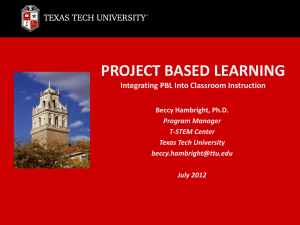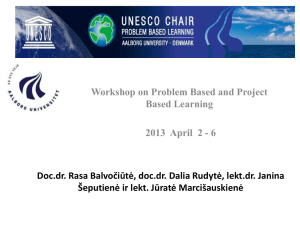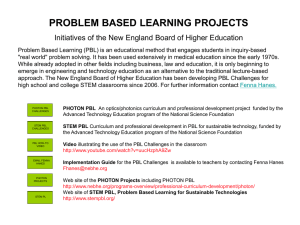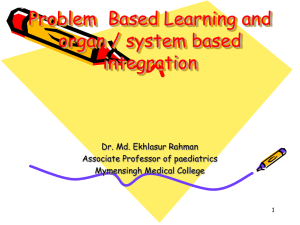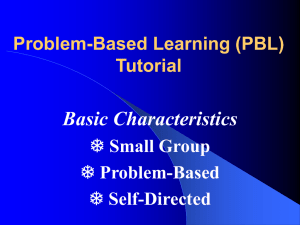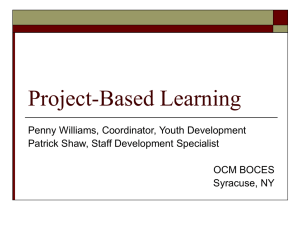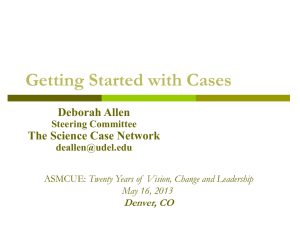PROJECT-BASED LEARNING
advertisement
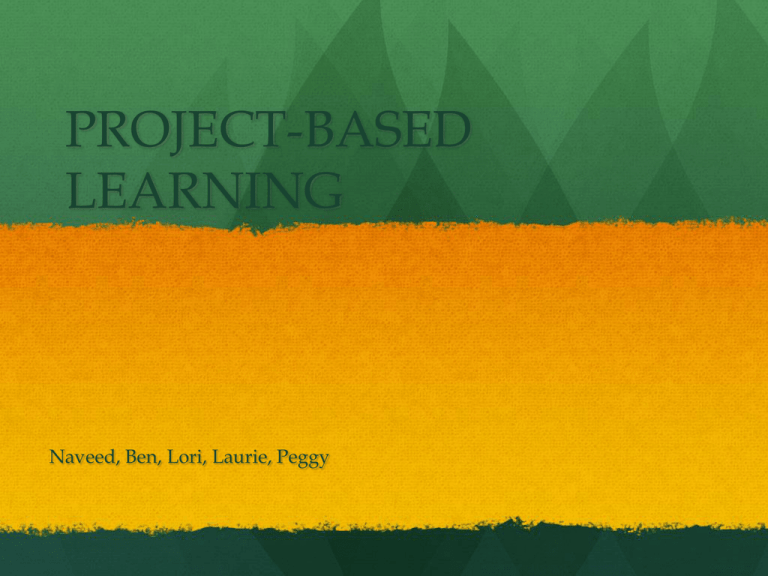
PROJECT-BASED LEARNING Naveed, Ben, Lori, Laurie, Peggy The Leading Question You’ve heard about Project Based Learning (PBL), but now you’re wondering….. Sure, it sounds good, but: Is it right for me and my students? Isn’t it a big change? Can I do it in today’s educational landscape? The answer is Yes, Yes, and Yes DOING PROJECTS Projects: Large activities completed after the students have been pushed through homework assignments, lectures, and readings. Usually a culminating event for a unit or semester. Writing Exercise Peer Edit Lecture Culminating Project Textbook Activity Lecture Textbook Activity Writing Exercise Project-Based Learning (PBL) Entry Document Writing Exercise Lecture Lecture Peer Edit Interview Lecture Writing Exercise Rubric What is Project Based Learning? Do you ever feel like you’re pushing students through the course you teach, or herding reluctant cattle with a combination of encouragement, rewards, and threats? In Project Based Learning (PBL), students are pulled through the curriculum by a meaningful question to explore, an engaging real-world problem to solve, or a design challenge to meet. Before they can do this, they need to work with other students to inquire into the issues raised, learn content and skills, develop an answer or solution, create high-quality products, and then present their work to other people. This process creates strong need to know and understand the material. And that’s the key to increasing students’ motivation to learn in PBL-give them real need to know, understand, and demonstrate what they learn, beyond simply getting a good grade. Essential Elements of PBL Significant Content At the core, the project is focused on teaching students important knowledge and skills, derived from standards and key concepts at the heart of academic content areas. 21st Century Skills Students build skills valuable for today’s world, such as critical thinking/problem solving, collaboration, and communication which are taught and assessed. In-Depth Inquiry Students are engaged in a rigorous, extended process of asking questions, using resources, and developing answers. Essential Elements of PBL (cont.) Driving Question Project work is focused by an open-ended question that students explore or that captures the task they are completing. Need to Know Students see the need to gain knowledge, understand concepts, and apply skills in order to create project products, beginning with an entry event that generates interest and curiosity. Voice and Choice Students are allowed to make some choices about the products to be created, how they work, and how they use their time, guided by the teacher and depending on age level and PBL experience. Essential Elements of PBL (cont.) Revision and Reflection The project includes processes for students to use feedback to consider additions and changes that lead to high-quality products, and think about what and how they are learning. Public Audience Students present their work to other people, beyond their classmates and teacher. Why Use PBL? Students gain a deeper understanding of the concepts and standards at the heart of a project. Projects also build vital workplace skills and lifelong habits of learning. Projects can allow students to address community issues, explore careers, interact with adult mentors, use technology, and present their work to audiences beyond the classroom. PBL can motivate students who might otherwise find school boring or meaningless. How Is PBL Used? Some teachers use PBL extensively as their primary curriculum organizer and instructional method. Others use PBL occasionally during a school year. Projects vary in length, from several days to several weeks or even a semester. PBL can be effective at all grade levels and subjects, and in career/technical education, afterschool and alternative programs PBL Misconceptions PBL is not: the dessert PBL is: the main course PBL is not: a string of activities tied together under a theme, concept, time period, culture, geographic area, etc. PBL Is: set of learning experiences and tasks that guide students in inquiry toward answering a central question, solving a problem, or meeting a challenge PBL is not: the same as “making something” or “hands-on learning” or “doing an activity.” PBL is: often focused on creating physical artifacts, but not always. It must involve other intellectually challenging tasks and products focused on research, reading, writing, discussion and oral presentation. PBL’s Effectiveness: What Experience and Research Tells Us Project Based Learning has had its advocates in education for many years, but more and more teacher and schools in the 21st century are recognizing its value. Classroom Teachers Based on their experience, teachers say that a welldesigned and well-implemented project: Can work for all kinds of students, with the right support Improve students’ motivation to learn Can be used to teach academic content standards Can include multiple opportunities to integrate technology Helps students see how school connects to the outside world by making learning relevant and meaningful Promotes greater civic participation and global awareness Researchers Researchers have found that well-designed and well-implemented PBL can: Be more effective than traditional instruction in increasing academic achievement Increase student motivation and engagement in learning Improve students’ retention of knowledge over time Improve students’ mastery of 21st century skills Be especially effective with lower-achieving students Increase students’ achievement on state-administered, standardized tests Schools Schools have used PBL effectively in all grade levels and courses, and for these special purposes: Career/technical education programs; continuation/alternative high school programs; after-school programs; summer school Integrating two or more school subjects and encouraging team teaching Connecting the school to other schools, the community, businesses, and other organizations Schools can help make PBL effective by creating a supportive culture, encouraging collaboration among teachers, providing PD, and developing school-wide practices and assessments The Role of the Teacher in PBL Once comfortable with PBL, most teachers say they would “never go back” Most enjoy their new role which allows them to work more closely with students, acting more like a coach instead of the “sage on the stage” If you enjoy being the center of attention this may not be for you May still be the need for lecture, structured lessons, or the need to direct students to resources Become manager of inquiry process, assessor of learning, and master of logistics Developing an Idea for the Project Remember the essential elements of PBL Places to start the Wheels Turning: The standards for the course you teach Your community What is relevant and interesting to your students What happens in the world outside of school Finding ideas from other sources: Your colleagues’ Online project libraries The teacher’s edition of your textbook or other materials from publishers Specifying Goals for Learning Know where you are going with the project Project should have multiple goals District standards State standards Business/industry standards 21st Century Skills Critical thinking Collaboration Communication Deciding on the Scope of the Project Imagine the possibilities, but know your limits and ask yourself the following: What requirements do you live with? What time frame do you operate in? What is your classroom like? What are your students like? What resources are available to you? Monarch Butterfly Project www.bie.org/videos/video/monarch_butterfl y_project References http://www.bie.org/

